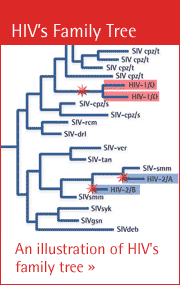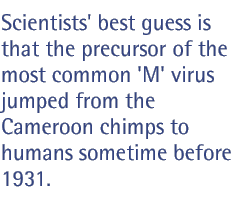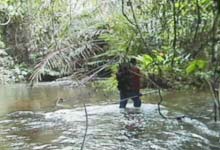Mary Carmichael is a Boston-based science writer.


As soon as HIV was identified in 1983, scientists started trying to understand where it had come from, when it had arisen, and why it had spread. Were they too late? To answer most of their questions, they would have had to witness the virus's evolution. Scientists can track new pathogens such as SARS and avian flu because they produce obvious symptoms almost immediately. But HIV is a stealth virus that takes as many as 10 years to present symptoms; by the time researchers knew enough to wonder about its origins, those origins were in the distant past.
For the last 23 years, scientists have been trying to peer into that past. Jon Cohen, a correspondent for Science who has written extensively about the virus, compares the work to fossil hunting, using a few precious shreds of evidence to construct a possible history. "Everybody's always looking for certainty. It doesn't exist [in this field]," he says. "In a sense it's all theory."
Nonetheless, the theory rests on facts, and at least a few of them are undisputed -- including, most significantly, HIV's family tree. There are two species of the virus, HIV-1 and HIV-2. The first evolved from a simian immunodeficiency virus (SIV) found in chimpanzees, while the second came from an SIV in a type of monkey called the sooty mangabey.
HIV-1, which is responsible for the vast majority of AIDS cases worldwide, is divided into three groups -- the "major" group M, and the much rarer "outlier" group O and "new" group N -- that have diverged over years of mutation and evolution. Within the M group -- which makes up 90 percent of all infections worldwide -- there are at least nine strains, known as "clades," of HIV-1 that are constantly mutating and merging with each other, creating yet more new varieties. "The M group epidemiologically has overwhelmed what else is out there," says Dr. Beatrice Hahn of the University of Alabama-Birmingham, who has conducted much of the research into HIV's origin. HIV-2, on the other hand, is not as virulent and largely confined to West Africa, where it originated.
In May 2006, an international group of researchers led by Hahn answered two major questions about the origin of HIV-1 M, the deadliest and most widespread form of the virus: Where was its cradle, and what kind of chimp did it come from? Answering the questions was literally messy work -- researchers collected 599 waste samples from wild chimpanzees and analyzed the viral particles they contained -- but the results were immaculate. Three populations of Pan troglodytes troglodytes living in southern Cameroon provided the crucial data. Two of those populations currently carry SIVs that are molecular dead ringers for HIV-1 M, while many chimps in the third group are infected with an SIV remarkably similar to HIV-1 N. Group O's simian sibling is probably lurking in other chimp populations in West Central Africa, says Hahn, adding that she has "a pretty good idea where it's going to be … and we're going to find it."
The research puts to rest decades of speculation about the birthplace of most types of HIV and their animal "reservoir" in the wild. But there are still many questions that haven't yet been definitively settled -- questions such as:
When did HIV-1 first start spreading in humans?
HIV-1 is surprisingly old, and it probably "debuted" in humans at least three separate times -- one for each subtype, M, N, and O. Scientists' best guess is that the precursor of the most common "M" virus jumped from the Cameroon chimps to humans sometime before 1931. Using samples of HIV-infected tissue harvested over the last three decades, virologist Dr. Bette Korber of Los Alamos National Laboratory has calculated that an ancestral form of HIV started spreading, slowly at first, in humans about 75 years ago. The actual jump from chimps to humans probably occurred shortly before that, says Hahn: "There's no reason to believe this was just lingering around in people."
Korber's model estimates a virus' age based on how extensively different strains have mutated. HIV is an unusual virus; it changes its DNA by both mutation and, more often, recombination, when two strains merge within the body and exchange genetic material. Some scientists refer to this process as "viral sex," and it may partially explain why it is so hard for scientists to make a treatment or vaccine. Korber's model does not take recombination into account, but given a virus' DNA configuration, it can roughly predict the age of that strain. Korber has tested the oldest known HIV sample, taken in 1959, and derived the 1931 estimate.
Why do scientists look at recent samples of HIV to determine the virus' overall age? Wouldn't it be better to use older samples that haven't had as much time to mutate?
It would, but scientists don't have that luxury. Other than the 1959 sample, there are very few preserved specimens of HIV-infected tissue that predate the early '80s, when the virus was first recognized by health authorities. Researchers still hope there are forgotten samples in African freezers. "There has to be some serum or plasma somewhere, and given modern technology we could fish out the virus," says Dr. David Ho, director of the Aaron Diamond AIDS Research Center and one of the world's leading authorities on HIV.
But even if those samples are found someday, they won't necessarily yield definite answers about the virus' age, says Korber: "Often, you can't get anything out of samples like that." Most African samples are made of blood serum, and serum samples contain viral RNA, which degrades much faster than the DNA found in tissue samples. In fact, says Ho, the 1959 sample, which was sequenced by his laboratory, was kept in a freezer but still didn't survive the ravages of time. "It was completely dried up," he says. "We were only able to get small pieces [of genetic material], and we had to stitch them together."
So scientists have estimated when and where the most deadly type of HIV started infecting humans -- but how did it do that?
Most AIDS researchers believe that the "bushmeat trade" allowed the HIV-1 virus, and separately HIV-2, to enter the human bloodstream several times. Hunters who kill and butcher chimps and monkeys are regularly exposed to animal blood teeming with SIVs. If the hunters have cuts, bites, or scratches -- and given the nature of their work they almost always do -- they can catch the viruses from their prey. Hunters going after chimps in Cameroon could have caught the first strains of HIV-1. Sooty mangabeys, hunted and kept as pets in West Africa, could have transmitted HIV-2 to humans.
Africans have hunted chimps and monkeys and kept them as pets for centuries; they've presumably been exposed to SIVs during most of that time. But the conditions needed for HIV to spread widely weren't in place until after the continent was colonized and urbanized. The first victims would have found it easier to unwittingly spread the virus to sexual partners far and wide as roads and vehicles started connecting previously isolated villages and cities. Hospitals may have played a role, too. Strapped for cash, some of them probably re-used dirty needles, unknowingly infecting patients in the process.
Are there other theories about how the virus could have gotten into humans?
There are several competing theories, ranging from implausible conspiracies to arguments grounded in extensive research. The best-known of the latter, the "OPV/AIDS" theory, was exhaustively detailed in the 1999 book The River, by author Edward Hooper. As many as a million Africans were given oral polio vaccines (OPV) between 1957 and 1960. Hooper says witnesses have told him that a few batches of those vaccines were "grown" in chimp cells at a lab in Kisangani, a city in the Democratic Republic of the Congo -- and that the chimp cells, and thus the vaccines, could have contained SIVs that jumped into humans. "There are highly significant correlations between the places where this vaccine was administered and the places where … AIDS first appeared on the planet four to 20 years later," Hooper says.

The majority of HIV researchers subscribe to the bushmeat theory and raise several arguments against the OPV theory. Hahn's recent research confirming that HIV-1 M and N arose from Pan troglodytes troglodytes chimps in Cameroon presents one problem: The Kisangani lab is in the Democratic Republic of the Congo, and it's home to a different subspecies of chimp than the one that was the source of HIV-1 M and N. However, it is possible that the chimps used in the Kisangani experiments were not from the area. In the spring of 2006, Hooper found a paper indicating that at least one of eight chimps at the Kisangani lab was a Pan troglodytes troglodytes.
The 1959 sample also presents a problem for the OPV theory. Judging by how fast the virus mutates, it had already diverged significantly from its SIV ancestors by the time doctors extracted it from a patient. However, the African polio vaccination program had begun only two years earlier, so under the OPV theory, the virus would have had only those two years in which to evolve. Dr. Ho, who sequenced the sample, says it looks like the virus has been around a lot longer than that.
Proponents of each theory have acknowledged (albeit grudgingly) that the other is scientifically possible. In the last two years researchers have found that both "simian foamy viruses" and at least two types of retroviruses can and do jump from monkeys to humans via hunting and butchery. And no one doubts that a vaccine cultured in primate cells could be contaminated with a primate virus. Some early polio vaccines contained SV40, a simian virus discovered in 1960, and the RNA virus that causes Marburg hemorrhagic fever.
The question is not whether either scenario could have happened -- it's which one did. To truly disprove the OPV theory, Hahn says, researchers would have to find HIV-infected human tissue samples that predate the polio vaccine trials. To prove the OPV/AIDS theory, on the other hand, they'd have to find the ancestral SIV in batches of the vaccine that were made in Kisangani. Neither of those things has happened, and it's possible they never will.
Why do we care? Does all this research into how the virus got started tell us anything about how to stop it?

Hunting chimps in West Central Africa.
Research into the HIV's origins may eventually yield practical results. It could help scientists understand why HIV's viral ancestor, SIV, doesn't kill or even sicken chimps who carry it. With that knowledge, researchers might be able to make drugs with fewer side effects, or broad-spectrum vaccines that protect against all the strains of the disease that infect people today.
Korber suggests that in an era of emerging diseases, looking back on the virus' shadowy origins offers a "history lesson," or perhaps even a fable, with a moral attached. By the time doctors realized that HIV/AIDS existed, it had already taken up permanent residence in humans. They couldn't have known about it before then, but, Korber says, at least now they know to be wary as the virus continues its shape-shifting spread around the globe. "The fact that it could be with us for quite a long time before we even realized it was there is kind of eye-opening," she says. "I think it's something to keep us on our toes. It helps us understand that we can be surprised." And of course, HIV research may have a few surprises left for us, too.


